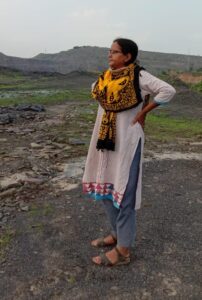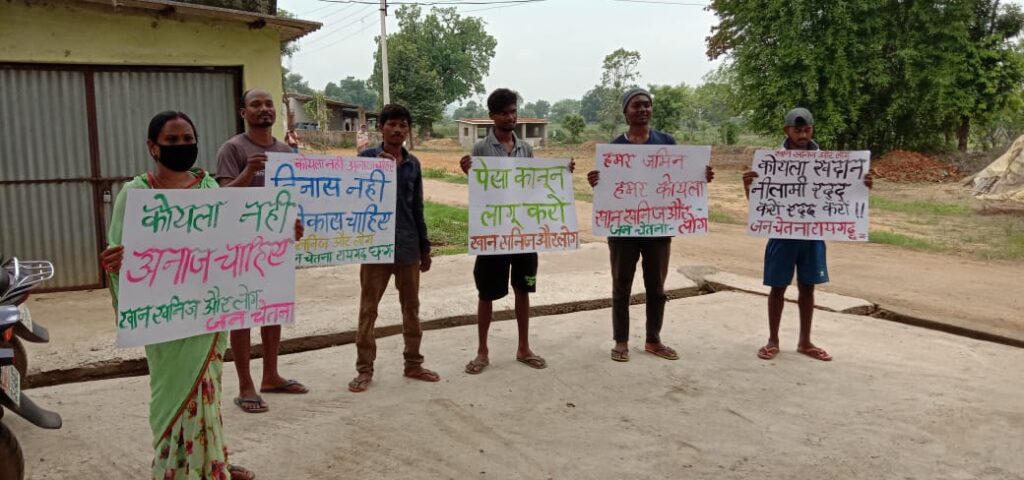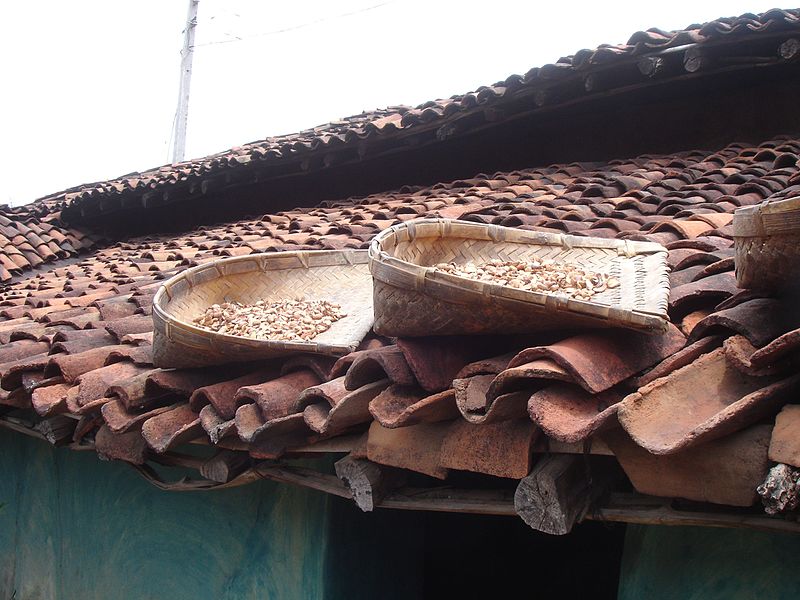
Savitha Rath is telling me a story, as she stands at a T-junction which is one of the few places with good phone connectivity. “While talking to you, I’m also giving out directions to different places for those passing by and asking for help!” she laughs, as she narrates how coal mining has changed the landscape around her.
In Chhattisgarh’s Raigarh district, “development” has come in pockets. In some places, mobile signals are erratic, while in other places, the roads are well-maintained. This disparate development doesn’t go unnoticed, especially when it has come at a huge ecological cost. “After coal mining has ruined our water and rivers, why is the government investing in roads instead?” questions Savitha.
Savitha is a human rights activist from Chhattisgarh. Responsible for 16% of India’s mineral revenue at ₹9183 crores, Chhattisgarh is the third-largest contributor of mineral revenue in the country. In 2018-19, almost half of the state’s mineral revenue came from coal. One of the top five coal-producing states, coal worth ₹27,956.88 lakhs was mined during the same years in Raigarh. In this eastern district, the Mahanadi flows across, dividing the district into two unequal parts, while its tributary, Kelo, snakes around a few blocks. This network of rivers and streams sustains forests of Sal, teak, and mahua amongst others, which cover 36% of the land in Raigarh.
On June 18th, the Central government launched the auctioning of 41 coal blocks for commercial mining: 9 of these are situated in Chhattisgarh and 3 are in Raigarh alone. 11 days later, communities residing close to these blocks staged a virtual rally.

“We strongly resist auctioning of any new coal mine here without keeping the public in the loop,” says Rajesh Tripathi, a participant of the virtual rally, and a member of the Jan Chetna collective. 19 districts of Chhattisgarh, including parts of Raigarh, are covered under the Panchayats (Extension of Scheduled Areas) Act of 1996 (PESA). The Act is meant to extend self-rule to tribal areas and protect their rights over land, water, and forests.
The auction of coal blocks for commercial mining is a historic step.
In a way, it marks the start of the much needed process to free the entire coal sector from decades of lockdown. pic.twitter.com/Wn7viz0uyI
— Narendra Modi (@narendramodi) June 18, 2020
Why are the residents protesting?
Diminishing Forests and Agricultural Lands
Coal production in Chirmiri (which was then a part of Madhya Pradesh) started as early as 1932. So, when Chhattisgarh was formed in 2000, mineral mining including coal had already gained momentum in the area. The operation of these coal mines ate into the forests and agricultural fields—both of which are central to the livelihoods of Adivasi groups like the Kawar and Binjwar, and even Particularly Vulnerable Tribal Groups like the Pando and Hill Korbas who reside here.
“Lakhs and lakhs of trees have been cut by companies like Adani, HINDALCO, and Ambuja. Many villagers depend on forest produce like tendu leaves and mahua to ferment local liquor, and as fodder for livestock—all of this has been destroyed,” says Kanhai Patel, former Panchayat member of Sarasmal Panchayat of Raigarh. A South Eastern Coalfield Limited (SECL) coal mine is barely 50 metres away from his home.

The loss of tree cover was reiterated by the Centre for Science and Environment (CSE), in its analysis of the Environment Impact Assessment of Jindal Steel Power’s Gare IV/6 coal mining project in Raigarh. Of the 381.42 hectares of the mine lease, the CSE analysis found that 93.64 hectares of it consisted of forestlands which would be completely destroyed during excavation. Further, it suggested that around 67% of the agricultural land will also be similarly “destroyed”.
A study by Savitha and her partners did further concludes that “Since 2000, in Raigarh district alone, 35,000 hectares of agricultural land have diminished under different development projects.”
In Dharamjaigarh, Raigarh’s other coal mining impacted block, Sajal Madhu alerts of an additional impact: elephant deaths. From 2019, talks of setting up a Lemru Elephant Reserve have been on. But, reports suggest that 19 coal deposits are present in the 1,995 sq km of the proposed reserve.
“Since 2001, 136 elephants have died under various circumstances in the block,” Sajal says. A former shopkeeper, Sajal now is an organiser with Bhoomi Bachao Sangarsh Samiti. A coal mine close to Sajal’s home has recently been auctioned; many elephants have been spotted there.

The elephants are already under threat from the East Rail Project, where a railway line is being laid to connect parts of Mand Raigarh Coalfield to Kharsia, a municipality. Reinforcing this, Chhattisgarh’s Forest Minister Mohammad Akbar recently wrote to the Central government to stop mining in the Lemru Reserve.
“It seems like the government neither cares for the people, nor for the forest or the animals,” Sajal laments.
Breaching Groundwater
The environmental problems do not end here: the consequences of coal-fired power plants have bagged Raigarh the position of the 47th most polluted city in the world.
Further, the groundwater in the district has been polluted. A 2017 Central Groundwater Board study found high fluoride concentration in the water—an element that is used in industrial processes. While the prescribed fluorine limits in water are 1-1.5 mg/l, the sample from Raigarh stood at 5.1 mg/l. This high concentration of the chemical in drinking water causes fluorosis; in 2018, reports emerged that almost everyone in a village in Tamnar, Raigarh, was suffering from decayed teeth, and pain in their bones and joints—all symptoms of this disease.
Interestingly, the same report also suggested that fluorosis existed despite six chemical removal plants installed in the area, which lay dysfunctional for two years. “Residents have been asking for the installation of these filters consistently over the years, but these requests have fallen on deaf ears,” says Savitha.
These demands pertain to the proper utilisation of funds under the District Mineral Fund (DMF)—a trust set up under the Mines and Mineral (Development and Regulation) Act, 2015, that works in the interest and benefit of persons and areas affected by mining.
Misprioritised Allocation of Funds under DMF
Funded through contributions from miners, the total money sanctioned under the DMF for Raigarh has been ₹15,448.99 lakhs. 51% of this money has been spent on completing 39 projects. 514 lie pending.
While this money should have been spent on projects on mining-impacted areas, a glance at the expenditure data shows that other non-impacted blocks have also developed projects using DMF funds. For example, drinking water purification has been the fourth-highest expenditure, but only one of the nine ROs was installed in a mining-affected area. A break-down of expenditure on health facilities also shows that the focus has been on providing “dead body vehicles” and ambulances, without any focus on health insurance or purchasing any equipment. No money has been spent on “pollution control measures”.
“No money under the DMF has been spent in our village, and this is true for most of the mining-impacted villages,” Kanhai says. “What we have been facing all these years is much worse than the current coronavirus pandemic!”
Now, in the light of the opening up of auctions by private companies, various people’s movements here are preparing to make themselves heard loud and clear under a united voice, “humar zameen, humar koyla”, which translates to “our land, our coal.”
“Humar zameen, humar koyla”
“We don’t want funds under the DMF at the cost of losing all our natural resources,” Savitha explains. “So, we are strongly resisting mining from entering new areas.”
But, wherever coal mines are operating, people are demanding transparency: where is the fund being used? Why is the DMF money not being prioritised according to the impacted villages’ needs?
Before COVID-19 hit, Savitha was holding training sessions in villages that would be impacted by the new coal auctions. The sessions covered the technicalities of EIAs, the details of the DMF and the Forests Rights Act, 2006, and the basics of filing applications under the Right to Information Act. “We encouraged the forest dwellers and Adivasis to file as many Individual Forest Rights under FRA as they could, so that the administration takes time to deal with them all before it can grant clearances,” Savitha says.
The communities are also filing for Community Forest Rights, especially over the hills that mark Tamnar, like Morga, which is not only an important source of livelihood, but also of religious significance too.
In addition to all of this, 70 villages in Raigarh have been observing a “Koyla Satyagrah” on 2 October every year since 2011. As a symbolic gesture, they pick up small lumps of coal from across the 750 acres of agricultural land donated by 600 nearby families listed under the name of a company of their own.

“Now that this land is notarised under our own ‘company’, why doesn’t the government let us do the coal mining instead?” says Rajesh Tripathi, who played a major role in rolling out this initiative. “Afterall, our livelihood comes from the forests around us, and our life is dependent on healthy natural resources. If we undertake coal mining, we would not do it at the cost of destroying the environment, unlike the other private companies. Isn’t that the true meaning of “Atmanirbhar”?
Featured image courtesy of Savitha Rath.







Thanks for sharing with us amazing information
hi sir’ you are greate for share the valuable knowledge paise kaise kamaye
[…] Nineteen districts of Chhattisgarh, including parts of Raigarh, are covered under the Panchayats Extension to Scheduled Areas Act (PESA), a piece of national legislation meant to extend self-rule to tribal areas and protect their rights over land, water, and forests. A raft of international human rights and domestic laws require Indian authorities to consult, and in some cases seek the consent of, Adivasi communities through general assemblies or Gram Sabhas before acquiring land or mining. However, these requirements are regularly flouted due to poor enforcement, and weak and contradictory laws. Additionally, discussions and transactions regarding resources and traditional lands exclude Adivasi women and are between the patriarchal head of the family and the state or corporate representatives. […]
[…] pensions from the sector, and settlements and other services are developed using funds from the District Mineral Foundation or from coal mining companies’ CSR programs. Even the Indian Railways generates revenue through […]
Its, a amazing and valuable content
nice post